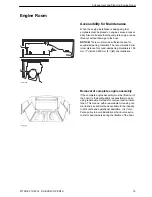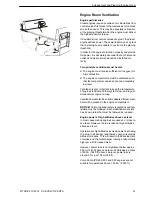
Sound Absorption
The drive assembly must be installed so that noise and
vibrations are minimized. The noise that occurs is party
airborne noise and partly structural noise (vibrations).
Structural noise
Engine vibrations are transferred to the hull via the
engine mounts and engine bed. Other transfer routes
are through the transmission and propeller system,
exhaust pipes, coolant pipes, fuel pipes and electrical
and control cables.
Propeller pressure waves are transmitted through the
water to the hull. Propeller drive pulses are transferred
to the hull via support brackets, bearings and seals.
Airborne noise
This section concerns airborne noise from the engine
compartment. The most important method of reducing
airborne noise from the engine compartment is to seal
it properly. Further noise reductions can be achieved
by laying sound insulation material and by designing
noise baffles in the air inlets.
The engine installation must be noise insulated to pro-
vide as low a noise level as possible. Build noise baf-
fles into the engine compartment. There are different
types of noise baffles to choose from. The illustration
shows a type that also provides drainage.
It is important to ensure that the insulation material is
sufficiently thick.
The greatest possible care must be taken to screen the
noise source as much as possible. Screen off the entire
bulkhead down to the hull, but leave a little gap so that
bilge water does not force its way into the insulation
material.
Cracks and openings etc. must be carefully sealed with
insulation material. In cases where the engine is instal-
led beneath the deck, all bulkheads and decks must be
insulated.
1
P0004735
Engine compartment noise baffles
Arrangement and Planning, Sound Absorption
30
47704162 10-2014 © AB VOLVO PENTA
Summary of Contents for IPS650
Page 1: ...IPS 2 IPS650 IPS800 IPS950 Installation 1 1 E ...
Page 2: ......
Page 156: ......
Page 160: ...47704162 English 10 2014 ...















































